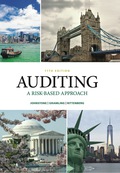
a.
Introduction: Internal control is an important part of every organization. It helps in maintaining the efficiency of the management. It is a policy used by the management to avoid fraudulent behavior and increasing accountability in the organization.
To state: The importance of internal control in an organization.
b.
Introduction: Internal control is an important part of every organization. It helps in maintaining the efficiency of the management. It is a policy used by the management to avoid fraudulent behavior and increasing accountability in the organization.
To state: The way in which internal control help in achieving reliable financial reporting.
c.
Introduction: Internal control is an important part of every organization. It helps in maintaining the efficiency of the management. It is a policy used by the management to avoid fraudulent behavior and increasing accountability in the organization.
To state: The need for external auditors to be aware of internal control over financial reporting of its client.
d.
Introduction: Internal control is an important part of every organization. It helps in maintaining the efficiency of the management. It is a policy used by the management to avoid fraudulent behavior and increasing accountability in the organization.
To state: Internal control over financial reporting and its components.
e.
Introduction: Internal control is an important part of every organization. It helps in maintaining the efficiency of the management. It is a policy used by the management to avoid fraudulent behavior and increasing accountability in the organization.
To state: Segregation of duties comes under which type of control and the risk it tries to reduce.
f.
Introduction: Internal control is an important part of every organization. It helps in maintaining the efficiency of the management. It is a policy used by the management to avoid fraudulent behavior and increasing accountability in the organization.
To state: The control activities C company would have implemented in order to prevent the fraud.
Want to see the full answer?
Check out a sample textbook solution
Chapter 3 Solutions
EBK AUDITING: A RISK BASED-APPROACH
- PLEASE HELParrow_forwardOne company might depreciate a new computer over three years while another company might depreciate the same model computer over five years...and both companies are right. True Falsearrow_forwardno chatgpAccumulated Depreciation will appear as a deduction within the section of the balance sheet labeled as Property, Plant and Equipment. True Falsearrow_forward
- No ai Depreciation Expense is shown on the income statement in order to achieve accounting's matching principle. True Falsearrow_forwardno aiOne company might depreciate a new computer over three years while another company might depreciate the same model computer over five years...and both companies are right. True Falsearrow_forwardno ai An asset's useful life is the same as its physical life? True Falsearrow_forward
- no ai Depreciation Expense reflects an allocation of an asset's original cost rather than an allocation based on the economic value that is being consumed. True Falsearrow_forwardThe purpose of depreciation is to have the balance sheet report the current value of an asset. True Falsearrow_forwardDepreciation Expense shown on a company's income statement must be the same amount as the depreciation expense on the company's income tax return. True Falsearrow_forward
 Auditing: A Risk Based-Approach (MindTap Course L...AccountingISBN:9781337619455Author:Karla M Johnstone, Audrey A. Gramling, Larry E. RittenbergPublisher:Cengage Learning
Auditing: A Risk Based-Approach (MindTap Course L...AccountingISBN:9781337619455Author:Karla M Johnstone, Audrey A. Gramling, Larry E. RittenbergPublisher:Cengage Learning Auditing: A Risk Based-Approach to Conducting a Q...AccountingISBN:9781305080577Author:Karla M Johnstone, Audrey A. Gramling, Larry E. RittenbergPublisher:South-Western College PubBusiness/Professional Ethics Directors/Executives...AccountingISBN:9781337485913Author:BROOKSPublisher:Cengage
Auditing: A Risk Based-Approach to Conducting a Q...AccountingISBN:9781305080577Author:Karla M Johnstone, Audrey A. Gramling, Larry E. RittenbergPublisher:South-Western College PubBusiness/Professional Ethics Directors/Executives...AccountingISBN:9781337485913Author:BROOKSPublisher:Cengage- Principles of Accounting Volume 1AccountingISBN:9781947172685Author:OpenStaxPublisher:OpenStax College
 Accounting Information SystemsAccountingISBN:9781337619202Author:Hall, James A.Publisher:Cengage Learning,
Accounting Information SystemsAccountingISBN:9781337619202Author:Hall, James A.Publisher:Cengage Learning,





